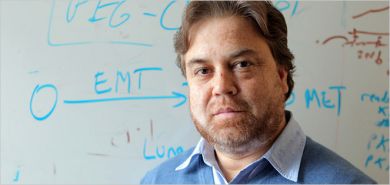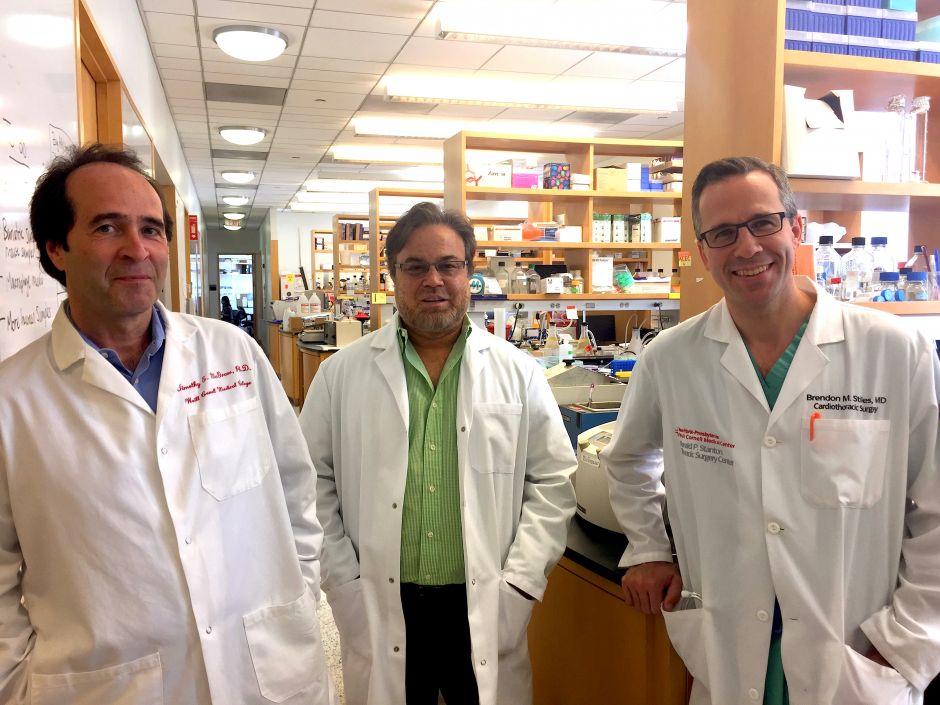Communication networks discovered between tumors and surrounding microenvironment
When cancer cells develop in a previously healthy organ, the surrounding area, called the microenvironment, directly influences tumor growth and disease spread. But how this happens was previously unknown. Now, a research team led by scientists at Weill Cornell Medical College and Houston Methodist Research Institute has identified complex communication networks between the tumors and surrounding complex milieu, which contains blood vessels, immune cells, connective tissue cells and structural cells.
The findings of this research, published Feb. 19 in Cell Reports, are the first that comprehensively look at crosstalk between a tumor and its microenvironment at this scale, said senior author Dr. Vivek Mittal, an associate professor of cell and developmental biology in cardiothoracic surgery at Weill Cornell Medical College. And the results, he said, could directly impact the way that cancer is treated.
"Current therapy rarely targets the organ cells that aid and abet tumor growth, so treatment of cancer is incomplete," said Dr. Mittal, noting that a tumor wounded by treatment can call on the microenvironment to survive.
"If you know how the microenvironment supports growth, progression and spread of cancer, you can begin to take apart these communications networks to find molecules that are vulnerable," Dr. Mittal said. "You might stop the cancer by disengaging the crosstalk."
In conducting this research, investigators studied a subtype of non-small cell lung cancer — the 25 percent that is driven by the Kras gene — because there is no effective treatment, with targeted therapies benefitting only 15 to 20 percent of non-Kras patients. There are 220,000 cases of lung cancer diagnosed each year, and it is the leading cause of mortality, accounting for more deaths than the three most common cancers combined, said Dr. Mittal, who is also director of the Neuberger Berman Foundation Lung Cancer Center Laboratory at Weill Cornell.
"Given the serious need for new therapies for lung cancer," he said, "decoding the tumor-microenvironment interplay will be a benefit to lung cancer treatment."
The researchers isolated specific individual cellular compartments directly from the lung tumor microenvironment and deep sequenced RNA of each compartment to accurately measure the activity of every gene. To explain their work, lead author Dr. Hyejin Choi compared lung cancer to a multilayered city infrastructure.
"The lung tumor is very complex, like New York City," said Dr. Choi, a postdoctoral associate at Weill Cornell. "And in lung cancer, there are individual cell populations, which each have a specialty, like the city has varied specialists — doctors, lawyers, police officers, etc. — who contribute to the development and growth of the larger whole."
Like these specialists within New York City, individual populations of cells within a lung cancer microenvironment contribute to tumor progression and growth. Their research, Dr. Choi said, identified and characterized these cell populations, and figured out what their role is in the larger cancer.
Once they had mapped these cell populations and their contributions, researchers compared their findings to the microenvironment of normal mouse lung tissue and analyzed data by developing a new computational program, known as Cell Cell Communication Explorer (CCCExplorer), which decodes how these genes are arranged within networks.
"We found that different populations of cells in the microenvironment talk to tumor cells through different signaling pathways," Dr. Mittal said. "This would not have been possible if we had examined whole tumor tissues and not individual components of the tumor."
"Cancer usually develops due to genetic mutations," he added. "Then its job is to get cell surrounding it involved in its survival and progression — and it does that in an amazing way by educating them and establishing cross-communication pathways. Using knowledge of these pathways and how they work opened up an unexplored area of cancer therapy."
While the pathways are identified, more research is needed to develop new therapeutic approaches, Dr. Choi said. Dr. Mittal agreed.
"So far we have only scratched the surface, and our goal is to identify all the networks and determine how they are modulated as a function of tumor progression," Dr. Mittal said. This research will then be used to understand how theses networks mediate responses or resistance to standard of care therapies in the clinic.
Moving forward, Dr. Mittal hopes that more research will continue to decode how this crosstalk works so that new therapies can be developed that are "not just targeted against mutations that cause the cancer," but keep the tumor from growing with the help of the microenvironment.
Dr. Choi also hopes that this research is applied to other types of cancer, like breast cancer and prostate cancer, which also call on a microenvironment for help.
"With this information on the crosstalk between the tumor and microenvironment," she said, "we could apply a similar approach to other tumor types and target them, too."
Read an additional interview with Dr. Mittal in Targeted Oncology.




